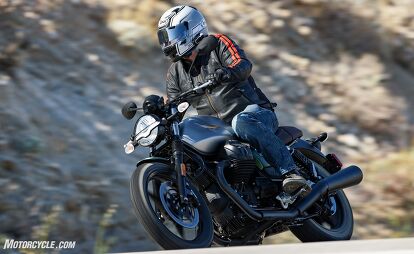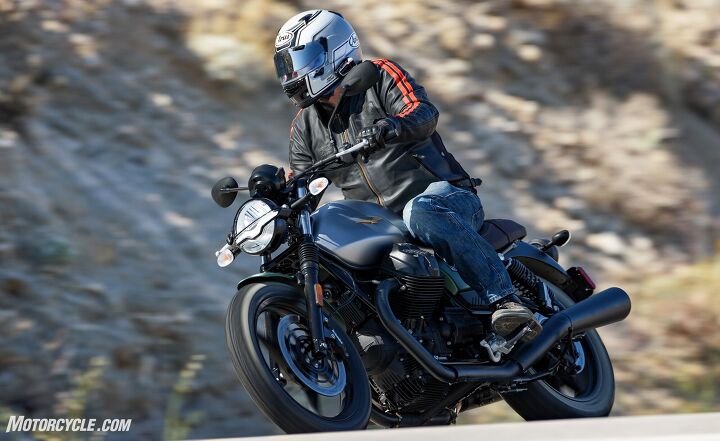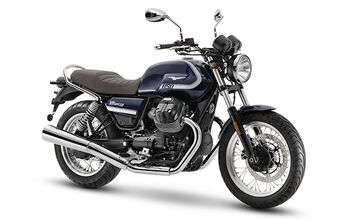2021 Moto Guzzi V7 Review - First Ride

The pleasures of elemental motorcycling
Remember the day you took your first long ride on your very first motorcycle? The weather was TV-commercial sunny as you rolled down the two-lane highway away from home. The wind flowing past your body was filled with excitement as the engine sang beneath your seat. You had the world by the handlebars, and you knew this was the beginning of Great Things, that many Good Times were about to be had – all because you had chosen to take your first steps towards becoming a motorcyclist. For many of us, it was this moment that set the hook, leading to a lifetime of motorcycling, and was less a decision and more of a calling than just about any experience before it. At least that’s how it was for me, and this is the memory I had during the first hour riding the 2021 Moto Guzzi V7.
2021 Moto Guzzi V7 Stone
| Engine | 16.0/20 |
| Suspension/Handling | 12.0/15 |
| Transmission/Clutch | 8.5/10 |
| Brakes | 7.5/10 |
| Instruments/Controls | 4.0/5 |
| Ergonomics/Comfort | 9.0/10 |
| Appearance/Quality | 9.0/10 |
| Desirability | 8.5/10 |
| Value | 9.0/10 |
| Overall Score | 83.5/100 |
2017 Moto Guzzi V7 III Stone Review
2016 Moto Guzzi V7 II Stone Review
You see, the updated Moto Guzzi V7 is so refined the specifics of the bike fade into the background, leaving behind just the essential experience of riding. Has technology finally advanced to the point that Moto Guzzi have created, paradoxically, the ur-motorcycle? What the hell am I writing about anyway?
In this era of technological refinement, where we have the ability to tune everything from throttle application and suspension damping to the rider’s specific desires with the flip of a switch, where every motorcycle feels designed to fit in a niche, within a niche, encompassed by the niche that is motorcycles, the Moto Guzzi V7 aspires to nothing more than being just a motorcycle and not a hyphenate. And for that, I’m truly grateful.
Happy 100th Birthday, Moto Guzzi!
The V7 is nothing new, really. It was first introduced in 1957. In 2009, it received a displacement bump to 744cc. However, with the 2021 model year, the displacement grows to 853cc, and the extra spit and polish put on by the brand to honor its 100th anniversary elevates the V7 pinnacle of pleasantness, a bike that, like the family dog, wants to go everywhere the road takes you.
And it all starts with the engine.
That transverse-mount 90° V-Twin
If you’ve been following the announcements about the V7, you know the engine is based on the one that powers the V85TT. But don’t mistake the engine for being transplanted into the V7. Rather, the engineers took what was learned with the V85TT and applied it to the specific needs of the V7. Consequently, the power numbers are quite different between the two.
With the bump in displacement comes an increase in power — 25%, according to Moto Guzzi – from a claimed 52 hp to 65 hp at 6,800 rpm. Claimed torque gets a step up to 54 lb-ft at 5,000 rpm, with over 80% available at 3,000 rpm. With all these numbers being measured at the crankshaft, we can expect the rear wheel output to be about 15% less, or roughly 55 hp and 46 lb-ft. Not earth shattering but still able to motivate 480 lbs. (again, claimed) with alacrity.
What those 853cc have going for them, besides a 84 mm x 77 mm bore and stroke, is a surprising freedom from vibration during operation – even at elevated rpm with a single-pin crankshaft. That 90° V plays an important role in the V7’s engine character.
There are many other changes to the engine that will mostly go unnoticed, but we’ll list them here since they combine to create one of the most pleasant power plants I’ve experienced in a standard motorcycle in a while. First, the engine cases were stiffened (for reliability) and dual oil pumps upgraded the semi-dry lubrication system to the point that no oil cooler is required to augment the air flowing over the cylinders sticking out of both sides of the motorcycle. The benefits of the new lubrication system include: no parasitic loss of power from the crankshaft contacting the oil, a lower max oil temperature, and an increased possible lean angle without affecting oil delivery.
The naked cylinder heads retain the two steel valves per cylinder arrangement of the previous generation and are operated with pushrods and rocker arms. Filling those cylinders is a single 38 mm Marelli throttle body with a traditional cable throttle control. According to Moto Guzzi, the frugality of the engine design allows it to be more powerful, cleaner, and more efficient than the 750 engine.
The best change, from the perspective of the rider, has to be the improvement of the single-plate dry clutch. With the previous generation, the range of engagement at the clutch lever was rather short, leading to lurches off the line. Happily, the 850 has no such issues, allowing the rider to slip the clutch more easily when leaving a stop. One thing hasn’t changed, though. The V7 still prefers you get the clutch fully engaged before you whack the throttle open in a hard launch. However, I doubt V7 riders will launch in such an aggressive manner, anyway.
Yes, there are electronics
While the V7 has a mechanical throttle, it still has some modern electronics. First, as with all European motorcycles, the brakes utilize ABS which cannot be turned off (though I fail to see why you’d ever want to do it on the V7). Despite the ever-decreasing cries of naysayers, ABS is a tremendous improvement in braking safety for riders, particularly when traction is limited in the rain. ABS is handled by a two-channel Continental system that monitors and controls the braking on each wheel separately.
The Moto Guzzi Traction Control (MGCT) limits rear-wheel spin in three settings: Standard, for sportier riding; Rain, for situations where traction may be impaired; and off, for those who require manual control. Standard proved to be just fine for everyday riding around town and motojournalist shenanigans out on the mountain roads.
Changes to the chassis
The area beneath the headstock (where the triple clamp attaches), a sheet of reinforcing steel was added, resulting in an increase of 10% in torsional rigidity. The benefits of this additional stiffness are reaped at high speeds in the form of increased stability, particularly in sweeping corners where chassis flex is highlighted.
The rear suspension was also updated. The longer shocks lay slightly more forward than previously. The dual shocks are larger and deliver a longer stroke for improved damping. Although adjustable for preload only, the springs are heavier and feature progressive winds on both ends. Attached to the frame at the engine and shocks, a new, beefier swingarm is utilized. The increased size and a new internal bevel gear were necessary to handle the increased engine output.
The non-adjustable 40 mm fork is more than capable of handling the type of riding for which this bike is designed.
Rubber meet road
While the list of changes to the 2021 Moto Guzzi V7 isn’t huge, the effect is immediately obvious to anyone who has ridden the previous generation. Not surprisingly, the engine starts immediately and settles into a steady idle, and no Moto Guzzi review would be complete without a mention of how the torque effect of the engine cranks the bike to the right when you rev the throttle at a stop.
Pulling away from a standing start is the first revelation. While I was prepared for the narrow clutch engagement range, the V7 delivered a nicely-sized friction zone in the middle of the lever travel. Riding around town highlights what a pleasant motorcycle the V7 is, and it is only improved by the increased torque in the bottom end. I could see myself happily commuting on this motorcycle. Every. Day.
After an extended ride at suburban speeds, we finally shed the confines of the Palm Springs area for the switchbacks of a climb up the adjacent mountains. The first thing I noticed was the seamless power delivery – both on and off throttle. Only the slightest bit of driveline lash marred the transitions from acceleration to deceleration and back again. Having the broad torque curve meant that shifting for a corner was frequently optional, and if I wanted to, running the engine up to its 7,000 rpm redline only brought the smallest amount of vibration into the pegs above 5,000 rpm.
One of the few surprises of the V7’s package is the single front brake. Yes, the bike is a reasonably light 480 lb. (claimed), but I would still like a dual disc setup. When it comes time to apply the front brake, the initial application is soft but the bite continues to build with the increase in lever pressure. The brakes have plenty of power to stop the bike in a hurry, but they do require a bit of effort.
With the rider in a neutral riding position, maneuvering the V7 is quite easy. The reach to the handlebar is comfortable, and the rider’s upper body is almost completely upright. Wind blast doesn’t pose a problem until the road speed gets above 75-80 mph. The 30.7 in. seat height should provide a fairly easy reach to the ground for most riders while still not cramping the legs of taller riders on long rides.
Riders who like to go around corners won’t be disappointed on the V7. The 28° rake means that it turns in quite easily (with an assist from the reasonable width of the handlebar), and cornering clearance allows for a fun amount of lean before the peg feelers tell you that maybe you should switch to a sportier motorcycle. On a ride that included both fast, sweeping turns and tighter, more technical corner series, the V7 never felt out of sorts all the way up to a 7-8/10ths pace.
As long as you keep the inputs smooth, the mostly non-adjustable suspension can handle the quick pace. Start manhandling the bike with abrupt brake or cornering inputs, and you’ll get the chassis pitch you’d expect from a suspension tuned for more everyday use. When it comes to being a daily rider, the suspenders deliver a comfy ride around town and even over the small sections of broken pavement I sought out in the nicely-maintained Palm Springs area. Some of the credit for this butt/bump happiness must be placed on the cushy saddle, which provided day-long comfort.
Three V7 models
Although all three Moto Guzzi V7 models are functionally the same, they do have some notable differences. First is the $8,990 V7 Stone, which is the base model and comes in Nero Ruvido, matte black; Azzurro Ghiaccio, a pearl sea blue; and Arancione Rame, a burnt orange. Aside from the painted fenders, tank, and side covers, the rest of the bike is blacked out with the only shiny accents being the fork tubes, the machined lines on the cylinder heads, and the V7 Stone logo on the sculpted side panels.
The second model, the V7 Stone Centenario, is really a V7 Stone of a different color – a limited edition for 2021 only color. For an extra $200, you get a snazzy silver and green colorway that harkens back to the famed Moto Guzzi dustbin racer, the Bialbero 350, which racked up 9 consecutive World Championships in the 350 class (5 for the rider and 4 for the manufacturer) from 1953 to 1957. The tank is a pearl, semi-matte silver, and the fender and side panels get the same treatment in green. A brown leather seat completes the $9,190 picture.
The V7 Special looks back stylistically to the original V7. The side panels get a retro stripe. The Special’s brightwork consists of spoked rims with polished channels. The exhaust is all chrome, and the engine’s cooling fins are machined to reveal the aluminum beneath the black powder coating. Unlike the V7 Stone, which has an LED headlight, the Special receives a halogen reflector headlight that matches the style of the bike. Sitting above the headlight are a pair of period-appropriate analog instruments. Other shiny parts include the shock springs and the passenger grab rail that wraps around a brown seat. The color options of this $9,490 motorcycle are: Blu Formale and Grigio Casual.
If the 2021 Moto Guzzi V7 Stone has piqued your interest, making you want to return to the early days of your motorcycling journey, take heart. All three variations will be available in dealerships sometime in April of 2021.
2021 Moto Guzzi V7
+ Highs
- More powerful, smooth engine
- Improved clutch engagement
- Modern looks with classic profile
– Sighs
- Needs dual front discs
- I only got to ride it for one day
- Do I really have to find three things to complain about?
In Gear

- Helmet: Arai Regent X $670
- Jacket: Alpinestars Oscar Charlie $650
- Jeans: Reax 215 Denim Riding Jeans $199
- Boots: Rev’It Regent H2O $350
Gloves: Reax Caster Sport $89
2021 Moto Guzzi V7 Specifications | |
|---|---|
| MSRP | $8,990 (Stone), $9,190 (Centenario), $9,490 (Special) |
| Engine Type | 853cc air-cooled transverse V-Twin, two valves per cylinder |
| Bore and Stroke | 84mm x 77mm |
| Rear Wheel Horsepower | 65 hp @ 6,800 rpm (claimed) |
| Torque | 54 lb-ft @ 5,000 rpm (claimed) |
| Transmission | 6-speed |
| Final Drive | Shaft |
| Front Suspension | 40mm, non-adjustable, 5.1-in. travel |
| Rear Suspension | Dual shocks with spring preload adjustability, 4.7-in. travel |
| Front Brake | Single axial-mounted four-piston caliper with full-floating 320mm disc |
| Rear Brake | Single two-piston caliper, 260mm disc |
| Front Tire | 100/90-18 |
| Rear Tire | 150/70-17 |
| Rake/Trail | 28 deg/4.1 in. |
| Wheelbase | 57.1 in. |
| Seat Height | 30.7 in. |
| Curb Weight (Claimed) | 480 lbs. (Stone, Centenario), 491 lb. (Special) |
| Fuel Capacity | 5.5 gal. |
Become a Motorcycle.com insider. Get the latest motorcycle news first by subscribing to our newsletter here.

Like most of the best happenings in his life, Evans stumbled into his motojournalism career. While on his way to a planned life in academia, he applied for a job at a motorcycle magazine, thinking he’d get the opportunity to write some freelance articles. Instead, he was offered a full-time job in which he discovered he could actually get paid to ride other people’s motorcycles – and he’s never looked back. Over the 25 years he’s been in the motorcycle industry, Evans has written two books, 101 Sportbike Performance Projects and How to Modify Your Metric Cruiser, and has ridden just about every production motorcycle manufactured. Evans has a deep love of motorcycles and believes they are a force for good in the world.
More by Evans Brasfield

















































































Comments
Join the conversation
beautiful machinery!
The original V7 twin came out in 1967, not 1957.